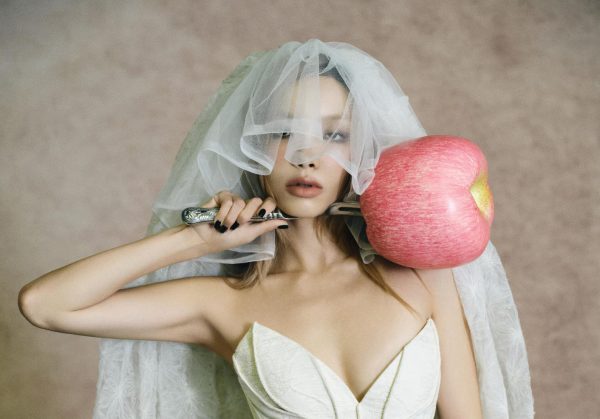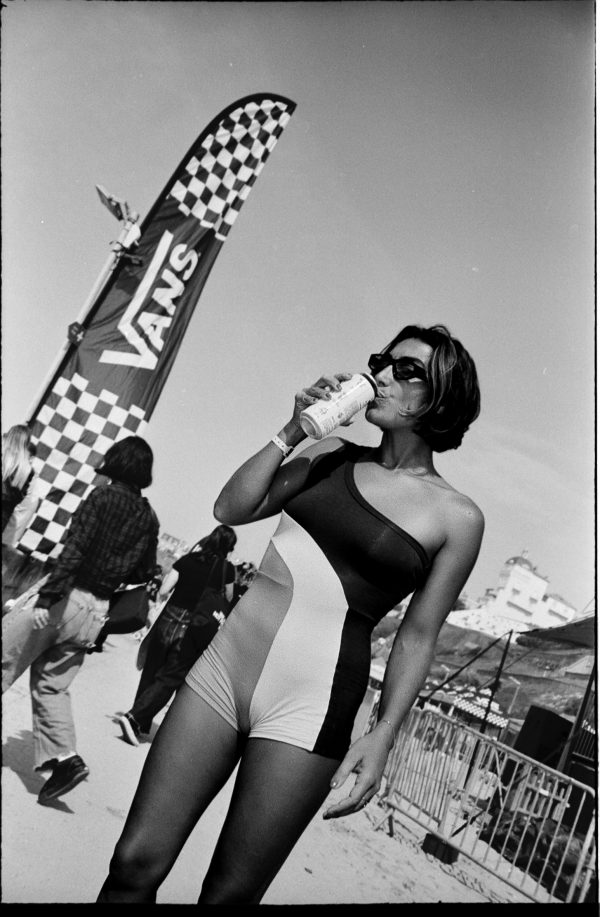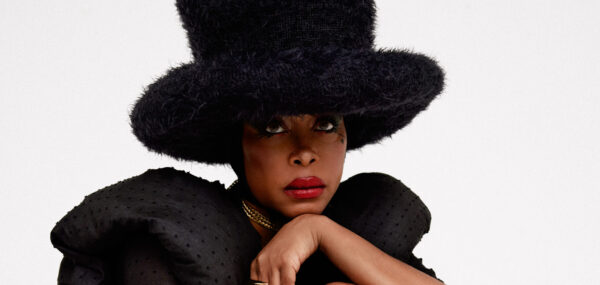
left
tank top. AMI Paris
right
shirt. Dries Van Noten
watch. Omega
Arnaud Valois has just returned from Cannes. The French actor has been in full promo mode, switching between photo calls and red carpets, interviews and shoots. Despite all the hustle and bustle, he looks serene as he settles down behind the bar for his Schön! interview. With his tall, striking demeanour and boyish good looks, it comes as no surprise that he was cast as the emblematic, fascinating Yves Saint Laurent in Disney’s 6-episode series, Becoming Karl Lagerfeld. Valois stars opposite Daniel Brühl, who plays Karl, and Théodore Pellerin as Jacques de Bascher, the enigmatic lover that linked the two power houses Yves and Karl. Arnaud Valois took on the responsibility of playing an iconic figure with enthusiasm and dedication. “It’s the first time I’ve played the role of a real person on screen,” he tells us, as he recalls the beginning of production on the series. “You can’t cheat, because in popular culture, everyone has an idea of who Yves Saint Laurent was.”
While many have the slightly older Saint Laurent in mind, Valois is keen to stress that we’ll discover a younger, slightly wilder version of the life of the iconic designer in this series: “The triangle that Saint Laurent was in with Jacques de Bascher and Karl is the focus, each of them involved in very different ways, and in their own personal way. It was interesting to be able to show the man of flesh and blood, even of other fluids… It’s very much about him in blood, flesh and sperm… it’s carnal, in short!”

full look. Dior Homme
Tackling the world of fashion historical dramas on screen is a feat. It means recreating icons on screen as well as producing the lush decors of various eras – in this case the decade between 1971 and 1981. For Becoming Karl Lagerfeld, Valois underwent a radical physical transformation to perfectly fit into the slim, svelte figure of Yves: “First of all, the physical transformation prepared me for the role. I lost 15 kilos, between the end of filming Good Grief and Becoming Karl Lagerfeld, I had 2 months to prepare and get under the skin of Saint Laurent.” The costumes were the next step to recreate the character, with some 20 custom-made costumes produced for Yves alone. “It was the first time I worked with custom-made costumes. It was a super strong tool to create the character. Everything was like a second skin – all these ’70s suits, extremely neatly tailored.” Study was another fundamental part of the preparation, with countless books and various visual sources as a basis for the research: “I would wake up at 2am and start reading his biography, I was obsessed. I wanted to see everything, hear everything, understand everything. I listened to the music he listened to. I read something like 6 biographies. There aren’t that many archival images of him, actually. I watched all the films he did costumes for, I watched all the films he loved – 1940s cinema, all the Visconti films, also contemporary films, Cruising, and others. He did a lot of costumes for the performing arts, which were a great inspiration.”
The series relates the events and steps that marked the advent of the two icons, tracing their careers around the intense love triangle that had both entranced. “You also get an insight into the relationship between them, because they were friends, him and Karl Lagerfeld,” Valois explains. “They started out together. A sort of twist of destiny meant that Yves Saint Laurent was at Christian Dior when Dior died, which propelled him to new heights unexpectedly. We also see his relationship with Pierre Bergé: I had this image of Pierre holding Yves Saint Laurent in this sort of cage, but it was far, far more complicated than that. You had to deal with Yves, on a daily basis – Pierre Bergé had the tools, the structure to allow him to express his talent. They were codependent, both responsible, with a definite sado-masochistic undercurrent in their relationship. Perhaps even in the bedroom, but I have no way of knowing that…”

left
shirt. Dries Van Noten
watch. Omega
right
coat + waistcoat. AMI Paris
“When I was preparing for the role, my boyfriend would say that there were three of us in the relationship. Him, myself and Yves,” Valois recalls, laughing. The profoundly transformative aspect of the work on the series was a challenge that Arnaud Valois embraced fully, bringing a much loved aspect of his theatrical background back into the mix. “I studied at the Cours Florent. After that, I moved quite quickly into working in cinema. I worked with Nicole Garcia on Selon Charlie, and it cut me off from theatre a bit, which was my first big passion. That was 20 years ago though… I hate that sentence! (laughs) It’s just surreal. I’m very happy with the twenty years behind me. The actors who did theatre didn’t do films, twenty years ago…” He mulls over the fact that the pact between the audience and actors in theatres is far more based on transformation, on projection, on imagination, a deal which is broken with the verisimilar undercurrent of cinema. With Yves, however, he was able to unveil some more exaggerated traits, play with his various characters, and push the acting process further. “His way of being in the world came with lots of layers – he had multiple identities: the genius, the intimate Yves, the night life figure, … I could be many characters at the same time, and exaggerate some of his traits too, like you do in theatre. There were multiple men in Yves. It’s a bit like the idea of the man and the artist. And yes, you can separate the two, by the way…”
Saint Laurent’s life brought a dose of chaos and violence with him, wherever he went. “He was fascinated by the loss of control, from his atelier to his private life, where he wanted to be abused in a way…,” Valois explains. “I don’t have that in me (thank goodness) so I tried to understand that. These roles are taxing – you can’t just pass through the experience, it required a total investment on my side. Not to the point of method, but close.” The passionate affair with Jacques de Bascher brought with it intensity and total dedication, an obsessiveness that seems to have characterised much of Yves Saint Laurent’s life. “For Yves, the way in which he fell in love with Jacques de Bascher wasn’t anything exceptional, insofar as when he fell in love with someone, his desire was absolute. He inundated him with flowers, letters, gifts, then moved onto the next person. There was nothing constant about him. Everything always had to be unique. Supreme. Flamboyant.”

coat + shoes. AMI Paris
jumper. Zegna
trousers. Dries Van Noten
We can’t help but wonder how this public figure would have fared in 2024, and whether the actions of the two designers – with all the changes that have surrounded power and influence – would have flown. “It’s interesting to ask yourself that question… They were so obsessed with beauty, with the absolute, that they ended up leaving a sense of humanity behind. That was very interesting to dwell on. To understand how a brain that puts art before anything else… it’s quite something.”
We wonder, also, how Valois has seen cinema change, in his own career. The discussion has been on the table in recent years, he remarks, with relief: “Now it has to be translated as actions. There’s a lot of work that’s done by associations, like 50-50, which I’m a part of, and The Syndicate of Actors. There are actors taking a stand, speaking out. Which is essential. It will be fruitful, it’s still long and slow but it will change. We’re struggling against millennia of patriarchy. It won’t happen overnight, but there’s something happening also in the content of the films that are being produced. Even if there wasn’t parity in terms of the films competing at Cannes, for example, there were a lot of films talking about women’s rights, trans rights. They’re the subjects on the table right now. We need to take action now.” The industry is one that maintained its status quo thanks to a silent majority. “Before, there was never a context, anything passed. Everyone was complicit.”

left
dinner jacket. Dior Homme
right
coat. AMI Paris
His faith in the power of cinema as an artform, however, remains unfaltering. “I think the power of images, whether it’s a film or a series, is super important as a vector for change in society.” One major moment for Arnaud Valois was with the 2017 film 120 BPM, by Robin Campillo, which tackled the AIDS crisis in France. “When we did 120 BPM, what struck me were the thousands of messages that I received from a young generation about AIDS, about the militants we were talking about, about speaking up,… it was crazy. That’s what’s sublime about these works. It doesn’t happen often, a film like that, in a career. Being able to mix substance and form, social questions, art – it’s mind blowing. It was an extraordinary moment.”
We come to a close discussing the upcoming European elections. “I will vote Sunday,” he confirms. In general, he says he is a “garçon optimiste”, but the situation that can be observed remains, quite simply, dire. Especially when discourses undermining gay and trans rights are rife and circulate freely. “I have a bad feeling about the years to come. I find it’s difficult to convince people that these extremist discourses aren’t for the better of all of us. I live in a bubble, I’m very privileged, as a starting point. My friends are artists, actors, so I’m in a very specific world. I’m not taking the difficulties of people’s lives lightly, I understand this cry of anger, but I don’t think that the National Front can solve their problems. I see the fractions become more extreme, the distance between a certain part of the population living in extreme poverty and some wealthy few becoming even richer. Almost like in South America. It makes me sad because I thought we were in a process of redistribution.”

left
tank top. AMI Paris
right
coat + waistcoat. Yohji Yamamoto
He speaks with bitterness of a recent incident whereby Marion Maréchal of the far right party Reconquête issued homophobic and transphobic statements about designer Simon Porte Jacquemus and his children, and about actress Karla Sofía Gascón and her work in Jacques Audiard’s film Emilia Perez, for which she won the “Prix d’Interprétation”, the Prize for a Lead Role, at Cannes – a first for a trans person in the history of the festival. “The hardest thing for me to understand is LGBTQIA+ people who vote for the Rassemblement National,” he states. “It’s harrowing. They’re people who profoundly hate us. But we’ll organise resistance, find ways to counterbalance all of this.”
What then, we ask, does the future hold for Arnaud Valois? “I’ve got a few projects I’m working on that I can’t talk about yet,” he teases. “I’m working on my second film as a director, I did a short a couple of years ago called Nouveau Moi. So I’m at the very end of the writing process of a film I’m directing called Encore. I hope to shoot soon. It’s about a crossed love story, but one that ends well. Because we’re optimistic.”
Becoming Karl Lagerfeld is available on Disney + here.
Interview. Patrick Clark
This Schön! editorial was produced by
photography. Tsuvasa Saïkusa
fashion. Patrick Clark
talent. Arnaud Valois
grooming. Ludovic Bordas @ Airport Agency
production. Clara Alapont
lighting. Léo Beauregard
special thanks. The team @ Madame Rêve, Annabelle @ Personae Consilium + Charlotte Touret
location. Hôtel Madame Rêve






























































































